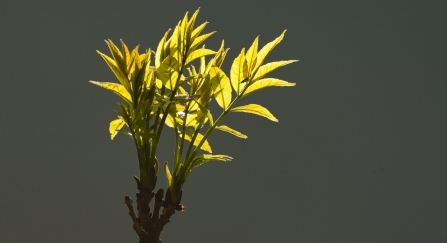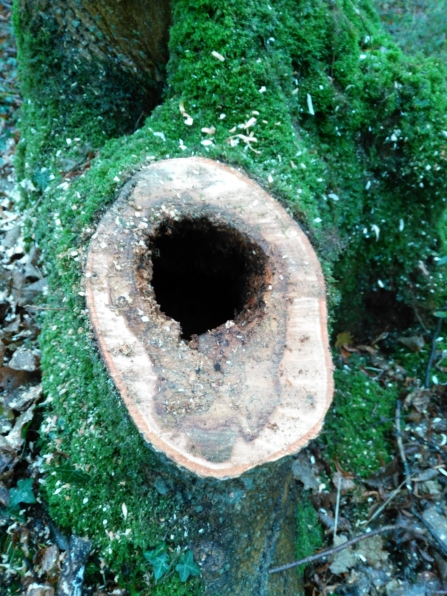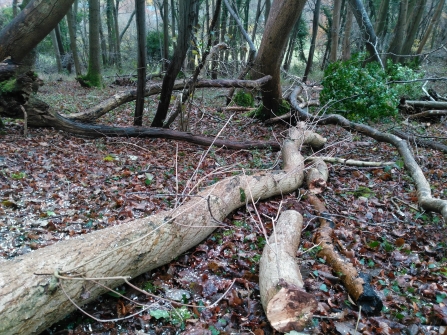A fatal fungal disease of ash trees
First confirmed in the UK in 2012, ash dieback, also known as 'Chalara' or 'Chalara ash dieback', is a disease of ash trees caused by a fungus called Hymenoscyphus fraxineus.
Ash dieback has already caused the widespread loss of ash trees in continental Europe and is now affecting countless woodlands, parks and gardens across the U.K, including our nature reserves.
The Trust manages 1,700 hectares of land in Somerset including many reserves with woodland and trees. Surveys across the woodlands are starting to identify that extensive areas of ash trees are infected by the disease. The Trust has removed some dangerous or fallen ash trees from areas including footpaths already and the concern is that these numbers will increase.
As our reserves are very popular with local people and visitors, public safety is a key concern. The Trust is carrying out an assessment of affected woodlands in line with updated guidance from the Forestry Commission and the National Tree Safety Group’s ash dieback guidance.
As such the Trust has determined that the selective felling of affected ash trees which stand beside public footpaths, bridleways, roads and other high risk features is the most appropriate action.
Find out more about ash dieback symptoms and our safety works below

Ash leaves - Mark Hamblin
Ash dieback symptoms
The main symptoms of ash dieback are:
- Blackening of leaves which often hang on the tree
- Discoloured stems, often with a diamond-shape lesion
- Black and shrivelled shoots
- The death of twigs and branches in the crown of mature trees
- Small white fruiting fungal bodies on blackened stalks in early autumn
The disease causes ash trees to die
Young ash trees die quickly, whilst mature trees can be killed by a yearly cycle of repeated infection. Diseased trees may also get honey fungus, causing branches or whole trees to collapse.

Chris Eyles
This photo shows the advanced rot in the centre of the stem of an ash tree recently felled at Cheddar Woods. This is most likely caused by a secondary infection, as ash dieback renders trees more vulnerable to other fungal pathogens such as honey fungus, which rapidly compromises the integrity of the timber and root system of the tree.

Chris Eyles
This photo shows the proliferation of epicormic growth of shoots out of the main stem of the same tree. This is a response to attempt to compensate for the death of the shoots at the end of the branches in the crown, and leads to a characteristic bushy “fox-tail” appearance of leaves near the stem when the tree is in leaf.
Ash dieback FAQs
What is ash dieback disease?
First discovered in the UK in 2012, ash dieback is a fungal disease affecting ash trees. The disease is now present in all counties of England. Experience in Europe suggests that the majority of ash trees in woodlands infected with the disease will decline and die.
How widespread is ash dieback in Somerset?
Somerset Wildlife Trust manages 1,700 hectares of land in Somerset. Assessment of affected woodlands have started to show extensive areas of ash trees are infected by the disease.
Why are you taking action now?
The Trust has carried out an assessment of affected woodlands in line with ash dieback guidance from the Forestry Commission. The Trust has also considered the National Tree Safety Group’s ash dieback guidance.
The presence of both ash dieback and honey fungus increases the risk of ash trees dying and becoming unstable. The Trust has already removed some dangerous or fallen ash trees from areas including footpaths and roads.
Public safety is a key concern as our reserves are very popular with local people and receive many visitors per year. Taking no action is not an option as the risk to public safety is considered unacceptable.
What action are we taking?
In order to protect public safety, the Trust will carry out the selective felling of affected ash trees which stand beside busy public footpaths, bridleways and roads over the next few years. Ash trees in the middle of woodland will be left for nature to take its course.
Which reserves will be affected?
All Somerset Wildlife Trust sites with ash trees are likely to be affected by the disease to some extent. We are taking a phased approach to dealing with the problem, with the following sites being badly affected and therefore areas for priority work in 2019/2020:
- Harridge Wood and Edford Wood
- Black Rock
- Rose Wood
- Cheddar Wood
- Aller & Beer Woods
- Langford Heathfield
Who is doing the work?
Somerset Wildlife Trust will be instructing specialist contractors to carry out the work, who are experienced at working on sensitive sites. The work will be carried out using machinery which fells the tree and takes the branches off mechanically. Due to the extent of the disease it is too dangerous to use chainsaw operators for this work.
How will the work impact wildlife?
We will prioritise felling during winter, outside of the bird nesting season, to minimise the impact on the environment and wildlife. As part of the works, we are liaising with ecologists to take protected species and wildlife into account and minimise impacts as far as possible. We will ensure the appropriate methodology and mitigation measures are followed.
Opening rides and glades will bring more light to the forest floor, so we may see more butterflies, orchids and other species benefitting longer term.
How will we replace the trees?
The woodlands will be left to regenerate naturally where ever possible with a range of tree species including, hopefully, some disease tolerant ash trees. Those ash saplings that are not resistant to the disease will die within a few years and will not pose a safety risk due to their limited size. If this does not happen, the area will be considered for restocking with an alternative native species. Progress will be reviewed on an ongoing basis.

